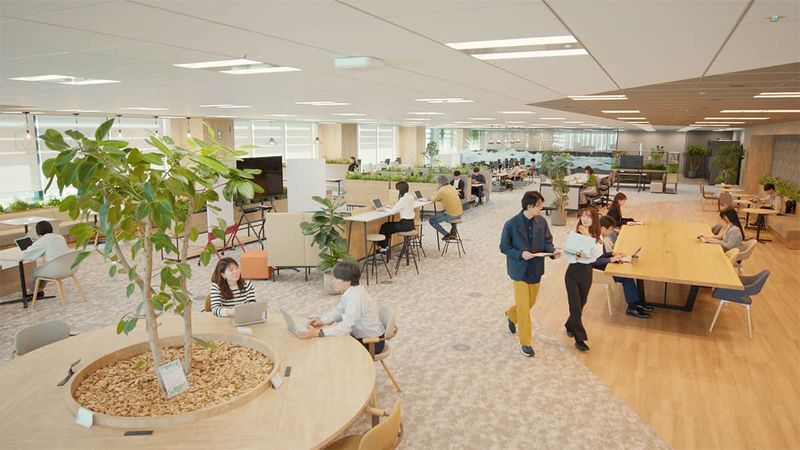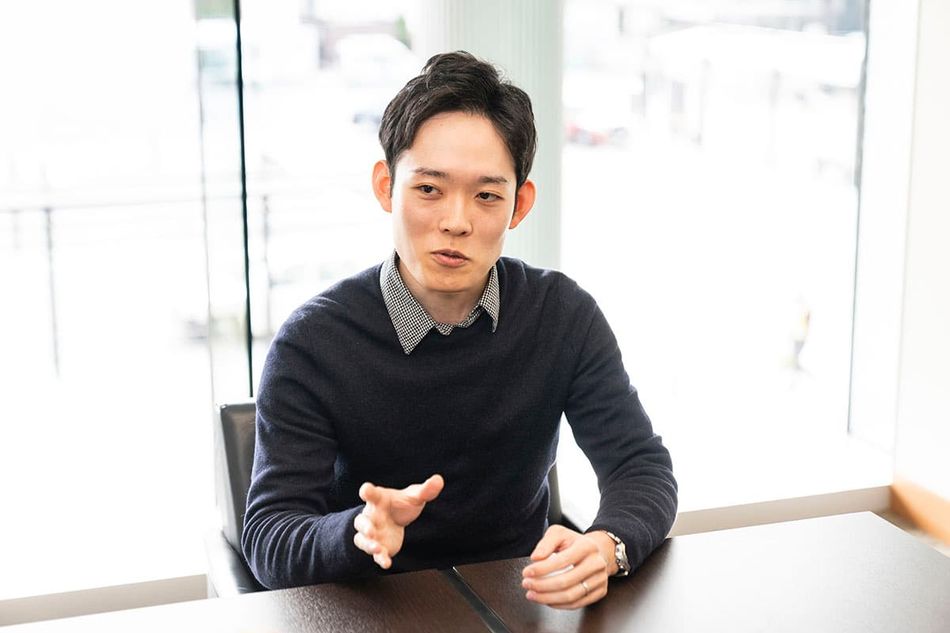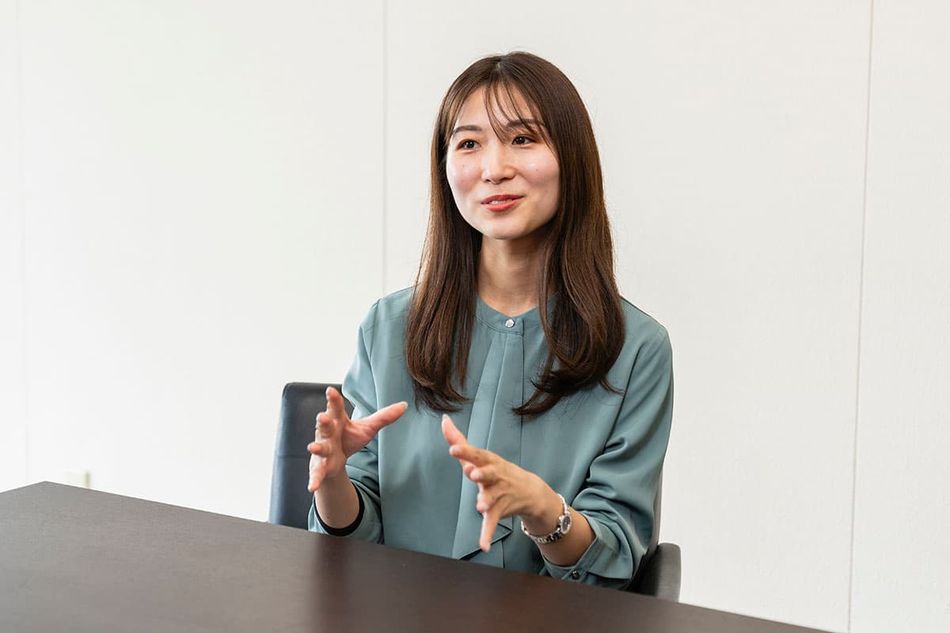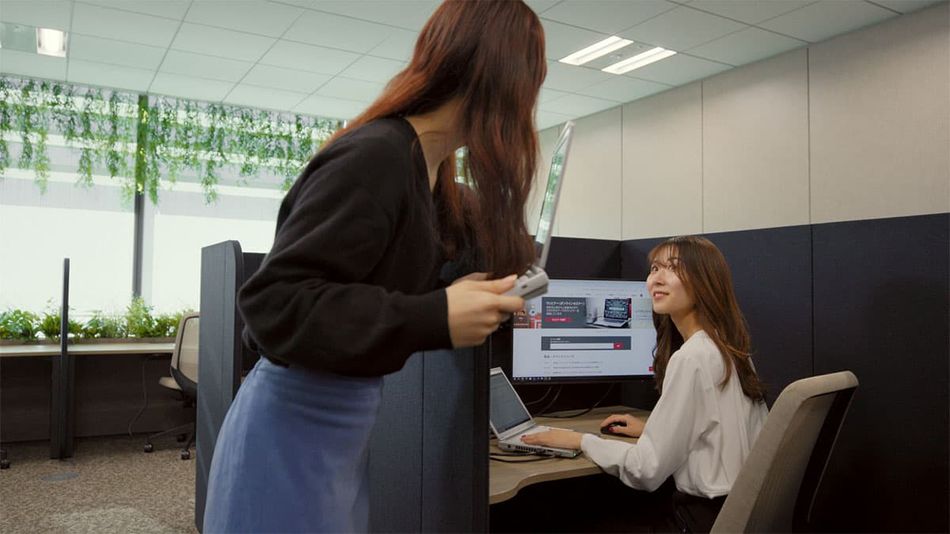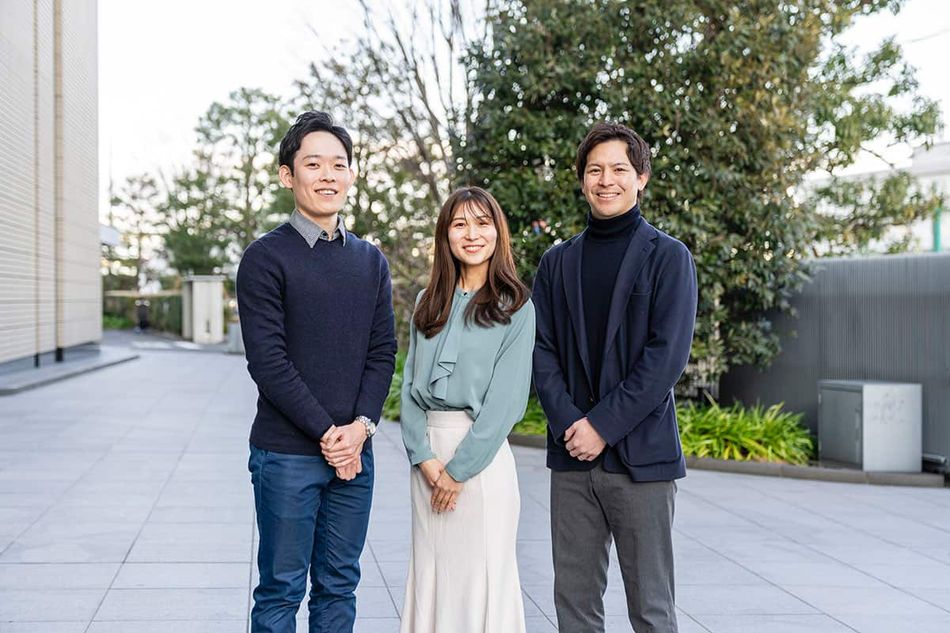Turning Offices with Hot Desking into the Ideal Space - Case Study of Hot Desking Using the Pifaa Seating Management System
For this article we interviewed Niwa and Omura, who are responsible for the design, development, and operation of the system, as well as Toda, who requested its development and is also a user.
This article was first published on
article.murata.comWith the diversification of working styles, such as working from home and staggered working hours, more and more employees are calling for offices to be made more flexible. However, there are also people used to traditional office work who feel concerned and reluctant toward flexible office spaces due to issues such as communication, securing seats, access to necessary equipment, and attendance management. Murata has been working on the development of a system that not only solves these problems, but also realizes a more comfortable office space.
For this article we interviewed Niwa and Omura, who are responsible for the design, development, and operation of the system, as well as Toda, who requested its development and is also a user. The three talk about what motivated the development, the challenges they faced, the benefits seen after its implementation, and their future hopes for the system.
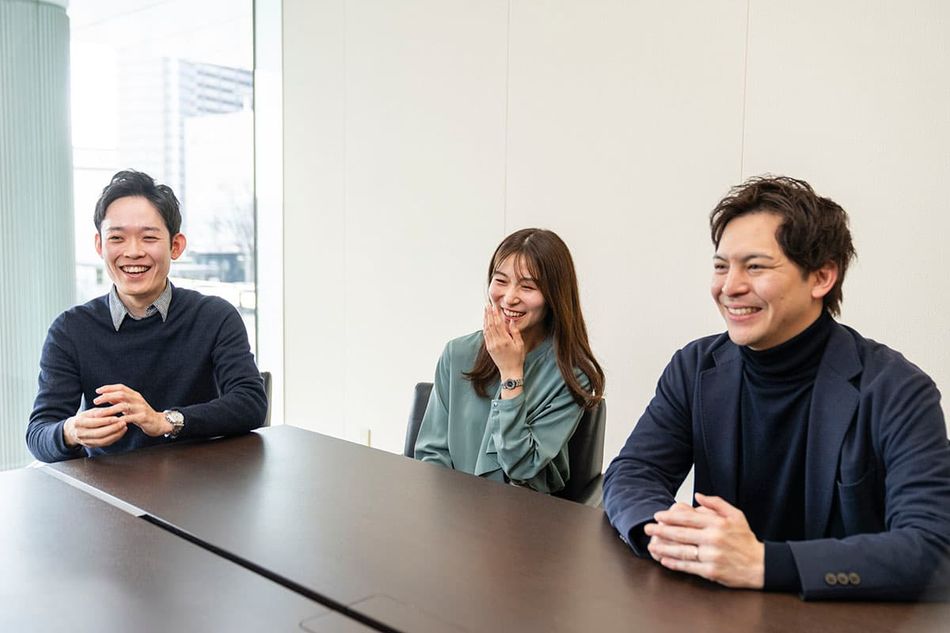
Niwa: Responsible for the product technology of the seating management system.
Omura: Product technology assistant.
Toda: In charge of new business planning in the department that requested the development of the seating management system.
The motivation behind creating a flexible office space
What motivated Murata to create a flexible office space?
Niwa: After the COVID-19 pandemic caused a rise in people working from home, Murata identified the need to review the way in which office seating was being used and manage seating more efficiently. Increased remote working also caused the issue of carrying out effective communication within the organization, leading to the desire to incorporate measures such as seating arrangements as ways of improving communication.
What specific problems were there, and what kind of requests did you receive?
Niwa: There are cases where there are multiple departments on one floor, depending on the range of responsibilities and market. These departments wished to change the seating layout, with the intention of improving cross-departmental connections.
Toda: On the floor of the new business department where I work, there were many people who were focused on individual work, and there was no culture of employees talking to each other apart from in meetings. There were few areas for open communication, such as whiteboards and meeting booths, and therefore even minor conversations were conspicuous. Murata had established a policy for creating flexible office spaces, and so we took the opportunity to make changes to the seating layout and address the problems on the floor at the same time.
The path to hot desking
What kind of efforts have you made to promote hot desking?
Toda: Before changing the seating layout, we first gathered information on the following:
・The work style and culture on the floor that the department manager (management level) is aiming for
・The needs that have become apparent for employees on the floor.
After reviewing the opinions that we received, it became evident that communication was lacking not only between different departments, but also within departments, and we concluded that we needed a seating layout that would stimulate communication. Moreover, while communication is important, we could not ignore the need for an environment in which one can concentrate on one's work, so we became aware that we needed a creative solution for assigning seats.
What kind of concept did you settle upon for the seating layout?
Omura: For general affairs and admin, a phone is necessary. Meanwhile, departments that specialize in development must have their own PCs, and they may require multiple monitor setups. The seating layout concept therefore took into account the need for such equipment.
Toda: A floor that achieves a good balance between communication and concentration. We felt that it was important to reduce the psychological barriers to casual conversation by establishing an area that promotes communication and allows you to flexibly change location depending on the kind of work you are doing. We also identified that people tend to fall into one of three categories: people who need a permanent seat, people who are completely comfortable hot desking, and people who want to stay together in a team. In particular, some managers expressed the desire to work in a group, as they were concerned that hot desking would disperse staff who had been used to working together in fixed seating, resulting in less communication.
The need for a seating management system in hot desking
In what situations is a seating management system necessary?
Niwa: A common occurrence when trying to secure a seat in a flexible office space is that you can't tell which seats are available. This also makes it difficult for superiors and managers to monitor who is at work, and where they are seated. This is an issue in terms of disaster prevention and safety management. Therefore, we felt the need for a system that makes it possible to manage the attendance of employees and the floor/seat where they are located.
Omura: On the floor that has been turned into a flexible office space, visitors from other departments found it difficult to find where the person they are visiting is seated. One solution would be to put nameplates on desks, but there are disadvantages as people often forget to display/remove them, and they are difficult to read from a distance. The best way to solve these problems is with a seating management system.
Introducing the Pifaa Seating Management System for flexible office spaces
What is the Pifaa Seating Management System?
Niwa: The most distinctive thing is that you can operate it with an employee ID card. All you need to do is hold your ID up to the reader when entering the room and entry is complete. As the system can be operated with an employee ID card, it can be used even on floors where camera-equipped devices such as smartphones are prohibited. You can also check seat availability and secure a seat on entering, or reserve a seat from your PC. Furthermore, as the system makes it possible to see the usage rate of seats, this information can be used to change the seating layout based on usage rate.
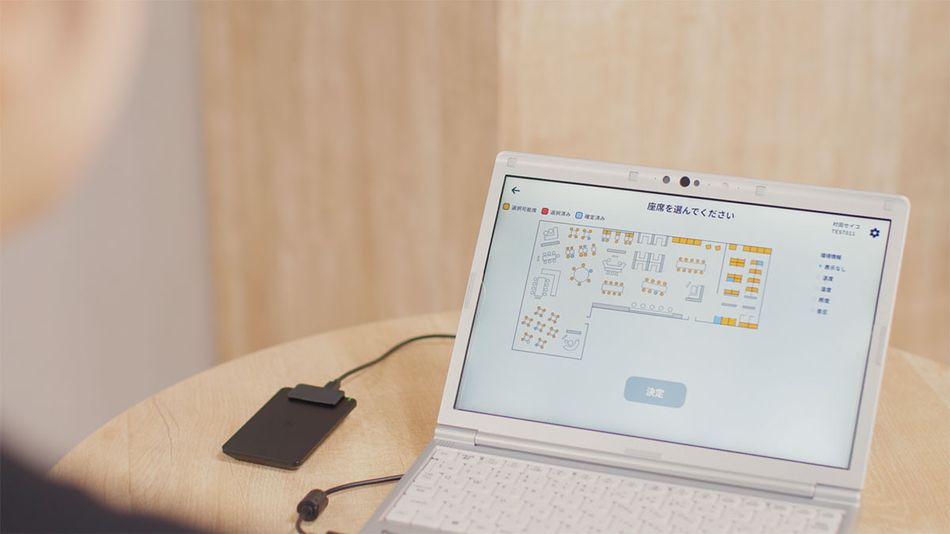
Omura: You can also search for where employees are seated by simply entering their name or department code. This means that visitors to the floor won't get lost.
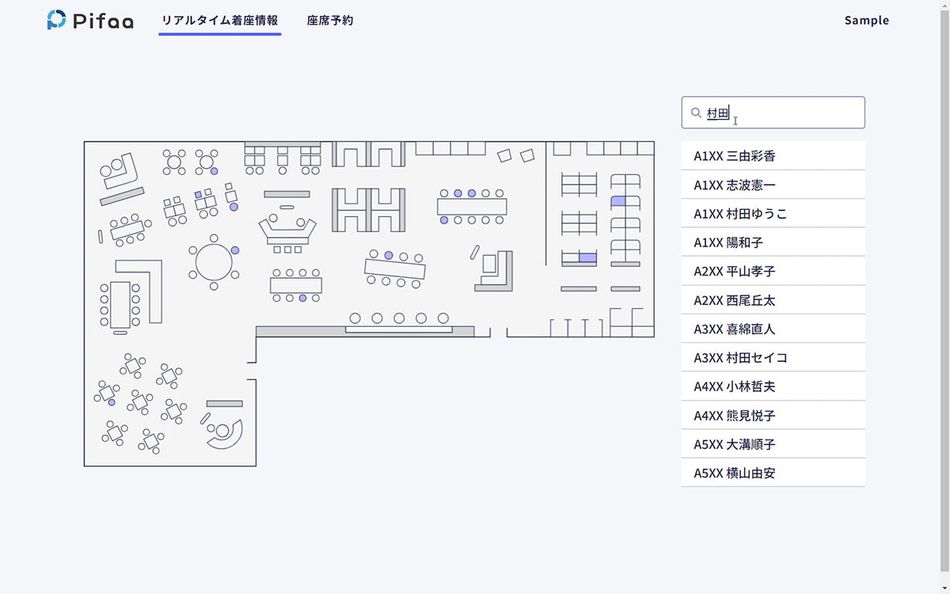
How did you create the floor maps?
Omura: In most cases, people make floor maps themselves using apps, etc., but this becomes a very complicated task when trying to establish partial fixed seating and hot desking. With the Pifaa Seating Management System at Murata, we got people from each floor to provide us with simple floor maps which we then used to create floor maps that are visually easy to interpret, and incorporated them into the system together with the detailed requirements that were requested.
A number of different sensors can be used with the Pifaa Seating Management System. What benefits do you think this will bring?
Omura: Pifaa's sensors include environmental sensors that can measure temperature, humidity, and atmospheric pressure, illuminance sensors that can measure brightness, and sound sensors that can measure sound pressure. The data from these sensors can be viewed on-screen when selecting a seat. This allows you to pick a seat in an environment that suits you. You can also use the sensor data to understand the usage rate of a specific area, such as a concentration area, communication area, or co-working space. The environmental information revealed by this quantified data can not only be used when selecting seats, it can also be used to visualize areas that are under-utilized and when reviewing soundproofing and air-conditioning.
Niwa: When introducing hot desking, it is common to establish various distinct areas, but the important point is whether or not they are being used as intended after going into operation. With Pifaa's sensors, it is possible to measure and visualize usage after going into operation. The layout of fixtures and seating can then be reviewed based on the visualization of the usage.
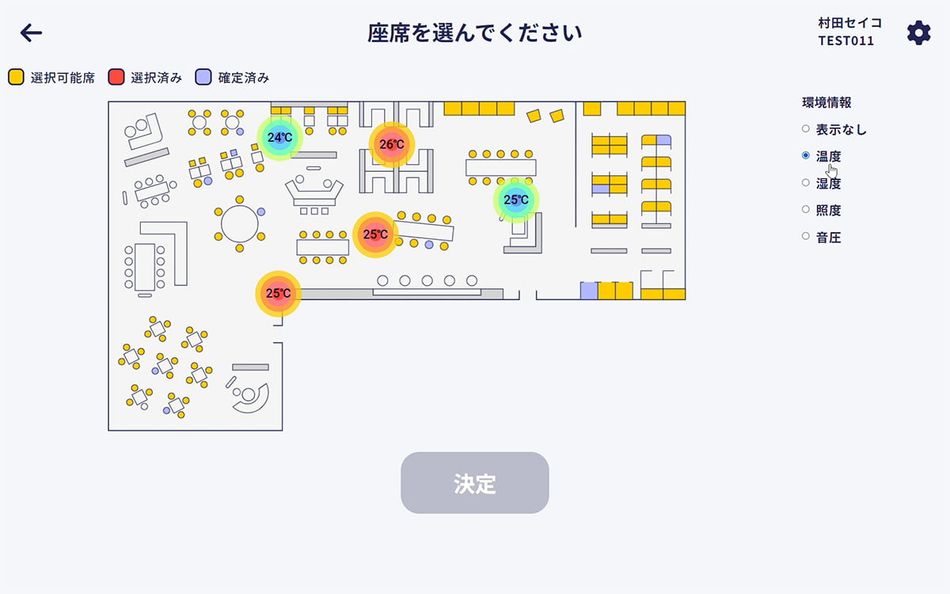
Observations after introducing the seating management system
What were the benefits of introducing the seating management system?
Niwa: Because employees can now choose a seating environment that suits their work style every day, we expect to see improvements in motivation and efficiency. The system has also removed the stresses of not knowing the availability of seats or whether the person you wish to speak to is at work that day. The reservation function has also resolved concerns such as not being able to sit due to a lack of seats. Furthermore, because seating is not fixed, communication and the sharing of information have become more active among staff from different teams and departments.
Omura: Even in the case of fixed seating, if seats are vacant due to working from home, etc., those seats can now be used freely. This allows us to be flexible with regard to the number of seats.
What was the reaction from users of the system?
Toda: In addition to being able to see the availability of seats and location of others at a glance, one major benefit is being able to gather data on the seating usage rate. In particular, since we are able to understand the daily seat occupancy rate and popular areas, we can base future layout change policies on this.
What are the benefits of seating management?
Toda: For requirements such as people who need a permanent seat, people who are completely comfortable hot desking, and people who want to stay together in a team, we've made it so that, for instance, only people who need a large PC for crunching numbers can choose permanent seats. We've also made it so that people with fixed seats can also use free seats. The Pifaa Seating Management System enables us to efficiently use the limited resource of seating by managing various conditions such as permanent seats and free seats.
What functions have helped to improve communication?
Omura: There is a random function. If you select this function, the system randomly assigns seats, preventing people from tending to sit near the same people. Using this function solves the issue of people tending to sit near the same people even in a flexible office space, and not making attempts to engage in more active communication.
Initiatives to sell the Pifaa Seating Management System to others
The Pifaa Seating Management System was developed by Murata, a manufacturing company, but can it be used in other industries?
Niwa: We have received praise regarding Pifaa's ease of use not only internally at Murata, but also from other companies to whom we have already delivered the system. The manufacturing industry in particular tends to have various diverse businesses mingled together on the same floor, including departments that not only use PCs but also various other measuring instruments and tools, departments that develop software, and indirect support departments. Even in these situations, I believe that Pifaa receives high praise because it is possible to select detailed settings according to the type of business.
Is there anything that you are paying particular attention to in selling the system to other customers?
Niwa: There is no functional difference between the system we use internally and the system that we sell to other customers. However, I believe that much discussion is required before introduction of the system, such as whether it can be operated with the type of employee ID used by the customer, the customer's company network environment, the layout of seats on each floor, etc.
Future hopes for the seating management system
Finally, please tell us about the impact the Pifaa Seating Management System will have on future office environments and future hopes for the Pifaa Seating Management System itself.
Niwa: I think that introduction of the Pifaa Seating Management System is the first step toward realizing a smart office (efficient operation of the office). It allows you to make the most of your office space, meeting the demands of diversifying work styles.
Toda: I am confident that the Pifaa Seating Management System is a system that will improve the office environment over the medium to long term by combining seat management and sensing technology, and that it is an indispensable solution for realizing the ideal smart office.
Omura: The system is not specialized for use in the manufacturing industry, and we plan to expand into other industries. We also assume that the system can be used not just at companies, but also university lecture halls, school study rooms, and libraries, and so that is something that we are also considering.
Summary - Editor's afterword
There are many services that enable office seating management. However, systems using beacons or smartphones tend to be costly to install and cumbersome to operate.
The Pifaa Seating Management System uses something that all employees are familiar with, their employee ID card, making it inexpensive to introduce and easy to operate. Furthermore, by utilizing Murata's sensor technology, employees can find the place that suits them best in the communal space of the office.
Employees are able to work in an ideal environment and understand each other through communication. It really seems like a solution that will help realize the smart offices of the future.
The Pifaa Seating Management System is only available in Japan.
The information contained in this article was correct as of the date the article was published. Exact system specifications and appearance are subject to change without notice.
